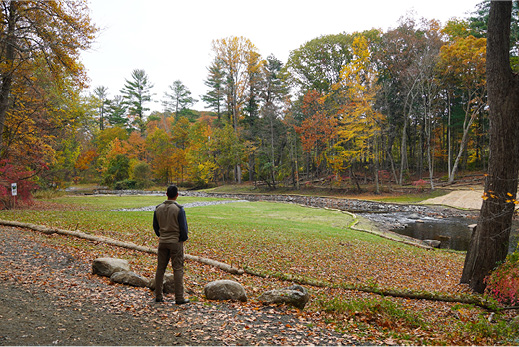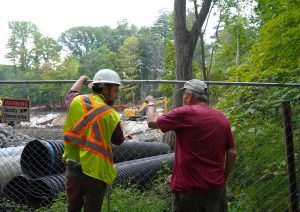By Lindsay Skedgell, Ecological Communications Specialist
Why remove a dam? What happens once a dam has been removed?

Save the Sound Ecological Restoration Senior Project Manager Paul Woodworth inspects the newly free-flowing Norwalk River at a monitoring visit shortly after Save the Sound’s removal of Dana Dam in Wilton, CT. The project reconnected 10 miles of river habitat that had been impeded for 80 years. © SavetheSound.org
These questions are explored in the Long Island Sound River Restoration Network’s (RRN) new Dam Removal Report. In the report, the RRN, a network of Connecticut and New York-based organizations dedicated to the restoration and health of the region’s rivers, presents the benefits of removing dams to restore free-flowing rivers. By collectively developing projects, sharing resources, communicating benefits of restored river systems, and coordinating with regulators and funders, the RRN is building regional capacity, resources, and support for dam removal.
“The reasons we remove dams are not always clear to the general public,” says Laura Wildman, vice president of ecological restoration at Save the Sound. “Dam impacts often go unnoticed because many are beneath the water’s surface. This report answers the question, ‘Why should we remove dams that no longer serve their intended purpose?’”
There are around 5,000 dams in Connecticut, equating to nearly one dam per square mile. In the New York portion of the Sound’s watershed, there are nearly 200 dams. Once built to divert or hold water for hydroelectric facilities, recreational use, navigation, water supply, and mechanical power purposes, many dams have become inactive.
Dams are barriers to the natural function and flow of rivers. Stream barriers pose several threats to our ecosystems, including interference with the migration of fish species that need to travel between saltwater and freshwater to reproduce. Many of these fish are keystone species, essential in the food chain. Their undisturbed passage through our waterways contributes to the overall health of our rivers, estuaries, and oceans.
Dams that breach or otherwise fail can also pose a threat to nearby communities through infrastructure flooding and the release of polluted sediment. With storms increasing in severity and many aging dams left unmaintained, the risk of dam failure is greater than ever, and growing.
“We’re seeing today the very real human cost of failure to maintain our dams,” Wildman continues. While Connecticut Dam Safety Division requires dam owners to inspect dams every few years, these regulations are rarely enforced. Additionally, downstream residents are not required to be notified of their proximity to a high-hazard dam with likelihood of breaching.
This January, the Fitchville Pond Dam on the Yantic River in Norwich and Bozrah, CT experienced a partial breach during heavy rainfall, which left around 5,000 residents without power and many with an emergency evacuation order due to infrastructure flooding.
But this story has a flip side: these dams can be removed, and when they are, the benefits are manifold. To illustrate the value of free-flowing rivers, the Dam Removal Report highlights a case study of Save the Sound’s past dam removal project on the West River in New Haven, Connecticut.
Pond Lily Dam was located on a highly developed portion of the West River. Removing it reconnected 2.6 river miles, reduced flood risk, and restored habitat. Post-removal monitoring showed that 76 acres of habitat were restored, and 60 times more alewife—a critical species of migratory fish that needs access to river habitat to reproduce—were present in annual fish runs five years after removal. Native wetland plants rebounded in the dam’s former pond impoundment, which contributed to increased biodiversity and resiliency.
The Dam Removal Report presents dam removal as a solution to preventing dam failure, one that decreases flooding, provides fish passage, and improves water quality.
 Save the Sound Ecological Restoration Project Manager Alex Krofta (left) answers questions from a community member as Dana Dam (Strong Pond Dam) in Wilton, CT comes down in October 2023.
Save the Sound Ecological Restoration Project Manager Alex Krofta (left) answers questions from a community member as Dana Dam (Strong Pond Dam) in Wilton, CT comes down in October 2023.
“The River Restoration Network saw a critical need to provide accurate and publicly accessible resources about the reasons to pursue dam removals and the benefits of doing so,” says Anthony Allen, director of restoration strategy at Save the Sound. “This report showcases the inspiring ways that nature can be restored, and communities made more resilient by removing ageing and forgotten structures that dot and divide our rivers.”
You can read a full copy of the report at SaveTheSound.org, and physical copies will be distributed at in-person events hosted by the RRN.
The Long Island Sound River Restoration Network comprises Save the Sound, American Rivers, Trout Unlimited, The Nature Conservancy, Seatuck Environmental Association, Connecticut River Conservancy, the Farmington River Watershed Association, and the Housatonic Valley Association. ■
